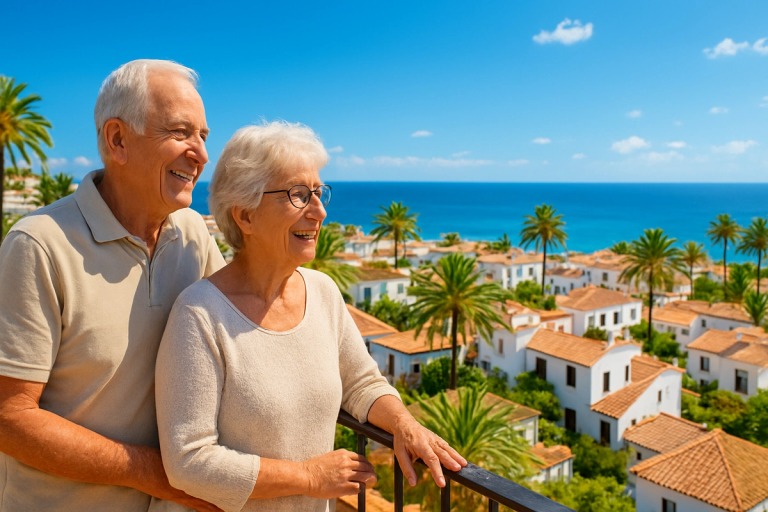Blog • Published on:October 20, 2025 | Updated on:October 20, 2025 • 15 Min
The Complete Guide to Retiring in Spain in 2025
There’s a reason so many people dream of spending their later years in Spain. Warm weather, incredible food, and a healthcare system ranked among Europe’s best, all make it a place where retirement actually feels like living.
But beyond lifestyle, Spain also offers one of the simplest legal routes for retirees. Through the Non-Lucrative Visa, often called the Spanish Retirement Visa, you can live in Spain long-term without working, as long as you meet the financial and documentation criteria.
In this guide, we cover:
- How the Spanish Retirement Visa works and what you need to qualify
- Updated financial and documentation requirements for applicants
- The real cost of living across major regions and islands
- How Spain’s public and private healthcare systems support retirees
- The best regions to retire, from Andalusia’s sunny spots to Valencia’s urban charm
Benefits of Retiring in Spain
Quality of Life and Mediterranean Lifestyle
Life in Spain can move in slow motion. Mornings stretch into late breakfasts, afternoons slow down under the sun, and evenings are for family, friends, and food.
Retirees enjoy the balance between social life, outdoor living, and peace, something most fellow European countries have long lost.
Spain ranks consistently high in quality-of-life indexes thanks to its low crime rate, reliable infrastructure, and climate that delivers over 300 sunny days a year in much of the south.
Cost of Living Advantages
Compared to France, Italy, or Portugal, Spain remains one of the most affordable Western European countries to live in.
A comfortable life for a couple is achievable on €1,500–€2,000 per month, depending on the region.
Rent, groceries, healthcare, and transport are all priced well below the EU average, especially outside Madrid and Barcelona.
Typical examples (2025 averages):
- One-bedroom apartment in Valencia city centre: €1,000/month
- Local meal: €12–€15
- Utilities for an 85m² flat: €130/month
- Monthly transport pass: €20–€50
Healthcare System Quality
Spain’s healthcare ranks among the top ten globally for accessibility and quality.
Retirees can join the public system through the Convenio Especial program or choose private insurance for faster service and English-speaking care.
Private plans for retirees start around €65–€150 per month, depending on coverage and age.
The system is modern, well-equipped, and trusted by international residents. Many doctors and specialists are multilingual, particularly in coastal regions like the Costa del Sol and Costa Blanca.
Spanish Retirement Visa Requirements
Understanding the Non-Lucrative Visa
The Spanish Non-Lucrative Visa is designed for retirees and individuals with a stable passive income who want to live in Spain without working.
It allows you to reside in the country for one year initially, with the option to renew for two-year periods.
After five years, you can apply for permanent residency, and later for citizenship if you meet all conditions.
Financial Requirements
To qualify in 2025, you must demonstrate sufficient financial means to support yourself without employment in Spain.
The threshold is based on the IPREM (Public Multiple Effect Income Indicator).
- Main applicant: Minimum income of €2,400 per month (€28,800 annually)
- Each dependent: Additional €600 per month (€7,200 annually)
Proof can include:
- Pension statements or retirement income
- Investment returns or property rental income
- Bank statements showing savings covering at least 12 months of living expenses
Documentation Needed
Applicants must provide:
- A valid passport (with at least one year before expiration)
- Completed national visa form
- Proof of financial means
- Private health insurance valid across Spain
- Medical certificate confirming good health
- Clean criminal record certificate from your country of residence
- Proof of accommodation (rental contract, property deed, or invitation letter)
All foreign documents must be translated into Spanish and legalized with an Apostille before submission.
Application Timeline
Applications are submitted to the nearest Spanish Consulate in your home country.
- Processing time: Typically 4–12 weeks depending on the consulate
- Once approved, the visa allows you to enter Spain and apply for your residence card (TIE) within 30 days at the local immigration office (Oficina de Extranjería)
The residence card is valid for one year, renewable if you continue to meet financial and insurance requirements.
Cost of Living for Retirees in Spain
Housing and Real Estate Costs
Housing is usually the largest expense, and it varies widely by region.
- Madrid and Barcelona: €1,000–€1,800/month for a one-bedroom central apartment
- Valencia or Málaga: €850–€1,300/month for a one-bedroom downtown apartment
- Alicante (Costa Blanca): €800–€1,000/month
Purchasing property is also popular among retirees. The costs per square meter in 2025 for central areas in the following cities are:
- Madrid: €5500–€10,000
- Barcelona: €4,600–€7,000
- Valencia: €2,500–€5,000
- Alicante: €2,100–€3,600
Foreigners can freely buy property in Spain, and many retirees prefer owning rather than renting.
Daily Living Expenses
Groceries and everyday services are generally affordable.
- Bread: €1.33
- Eggs (12): €2.67
- Chicken (1kg): €7.34
- Local restaurant meal: €10–€20
- Mid-range dinner for two: €35–€80
Utilities for an average 85m² flat cost around €85-220/month, including electricity, water, and gas. High-speed internet packages start from €20/month.
Healthcare Expenses
If you enrol in the Convenio Especial public health program, the monthly contribution is:
- €60 for retirees under 65
- €157 for retirees over 65
Private health insurance plans vary from €65 to €150 per month, depending on coverage and age. Many retirees choose a mix of both systems, using the public network for routine care and private clinics for faster appointments.
Utility and Transportation Costs
Spain’s public transport is extensive, clean, and cheap.
- Monthly pass: €20–€50
- Single ticket: €1.05–€2.55
Owning a car is optional, fuel costs average €1.54 per liter, and parking in major cities can be expensive.
Overall, a single retiree can live comfortably on €1,750–€1,000 per month, while a couple can expect €1,500–€2,000 depending on lifestyle and region.
Best Places to Retire in Spain
Spain’s diversity is one of its biggest advantages. You can live by the sea, in a peaceful village, or in a busy city, all within a few hours’ drive.
Below are the top regions retirees choose based on climate, affordability, and lifestyle balance.
Costa del Sol
Southern Spain’s Costa del Sol remains the most popular retirement region, stretching from Málaga to Marbella. It offers year-round sunshine, modern healthcare, and a large international community, especially from the UK, Germany, and Scandinavia.
- Average rent (1-bedroom): €500 to €3,500
- Average Property price: €3,842/m²
- Notable towns: Marbella, Estepona, Nerja, Fuengirola
- Airport access: Málaga International Airport connects to over 145 destinations
Its strong expat infrastructure makes daily life easy, English-speaking doctors, international supermarkets, and social clubs are everywhere.
Valencia and Alicante
The Valencian Community combines coastal life with cultural depth. Valencia, Spain’s third-largest city, offers modern amenities, top hospitals, and a lower cost of living than Madrid or Barcelona.
Alicante, meanwhile, is ideal for retirees looking for a slower pace near the beach. The city’s climate, walkability, and affordability make it one of Europe’s best retirement spots.
- Average rent: €825–€1,100/month
- Property price: €2,560–€3,730/m²
- Public healthcare ranking: Among Spain’s top 5 regions
Balearic Islands
For retirees drawn to island living, Mallorca, Menorca, and Ibiza blend Mediterranean beauty with stable infrastructure.
Mallorca is the most popular for long-term residency due to its balance of calm lifestyle, healthcare access, and international connectivity. Capital Palma de Mallorca makes for an ideal base.
- Average downtown rent: €950–€1,500
- Central property price: €4,000–€6,500/m²
- Key advantage: International airport and high-quality private clinics
Madrid and Surroundings
Spain’s capital isn’t the cheapest, but it’s ideal for retirees who prefer culture and convenience over coastlines.
Madrid offers world-class healthcare, efficient transport, and hundreds of cultural activities.
Towns like Toledo, Segovia, and Alcalá de Henares nearby offer quieter, cheaper living while staying close to the capital.
- Rent in central Madrid: €1,300/month
- Rent outside city: €950/month
- Property price: €3,200–€10,000/m²
For retirees interested in combining lifestyle with long-term residence options, Madrid’s urban hubs are also best suited for visa renewals and administrative processing.
Healthcare Options for Retirees in Spain
Spain’s healthcare system ranks among the best in the world.
It offers high-quality medical care, affordable private insurance, and a strong public network accessible to residents.
Public Healthcare Access
Spain operates a universal healthcare system funded through taxes and available to legal residents.
Retirees holding the Non-Lucrative Visa can access it by enrolling in the Convenio Especial program, which provides full medical coverage, including general practitioners, specialists, and hospital care.
Contribution rates:
- €60 per month (under 65)
- €157 per month (65 and above)
Once registered, retirees can visit local health centers (centros de salud) and hospitals under the Servicio Nacional de Salud (SNS).
Prescriptions are heavily subsidized, in most regions, seniors pay only 10–20% of the cost of medicines.
Private Health Insurance Requirements
Before applying for a Non-Lucrative Visa, retirees must show proof of private health insurance valid throughout Spain. The policy must include:
- No co-payments (full coverage)
- Minimum coverage equivalent to Spain’s public system
- Coverage for hospitalization and repatriation
Private insurance gives faster access to specialists and English-speaking doctors. Plans typically range from €65 to €150 per month, depending on age and coverage.
Medical Facilities and Services
Spain’s healthcare infrastructure is modern and extensive:
- Over 400 public hospitals and more than 200 private clinics nationwide
- Major cities like Madrid, Valencia, and Málaga have internationally accredited hospitals
- Many medical professionals speak English, especially in coastal and expat-heavy areas
The combination of public access and private options means retirees rarely face long waiting times for treatment.
If you’re planning a long-term stay, read our detailed Living in Spain Guide for a full breakdown of healthcare access through Spain’s residency programs.
Legal Requirements for Retirement in Spain
While the process is relatively straightforward, accuracy and preparation make all the difference in ensuring approval and maintaining legal status.
Residency Permit Process
Non-EU retirees typically apply for the Non-Lucrative Visa (NLV), Spain’s most common retirement visa.
This visa allows foreigners to live in Spain without engaging in any work or business activity.
Key requirements for the Non-Lucrative Visa in 2025:
- Minimum monthly income: €2,400 (or €28,800 annually)
- Additional €600 (€7,200) per dependent
- Proof of private health insurance
- Clean criminal record
- Medical certificate confirming good health
- Proof of long-term accommodation (rental or ownership contract)
Once approved, the visa is valid for one year, renewable for two years at a time.
After five years, applicants can obtain permanent residence, and after ten years, they may qualify for Spanish citizenship, explained in our Spanish Citizenship Guide.
NIE Number Application
To manage financial and administrative tasks in Spain, every foreigner must obtain a NIE.
You’ll need the NIE to:
- Open a bank account
- Sign a lease or property deed
- Pay taxes and utility bills
- Register with healthcare providers
The NIE can be applied for at a Spanish consulate abroad or through a local immigration office after arrival.
Tax Considerations
Spain’s tax residency rules depend on time spent in the country.
You’re considered a tax resident if you:
- Spend more than 183 days per year in Spain, or
- Have your main economic or family interests located in Spain
Key tax points for retirees:
- Tax residents are taxed on worldwide income
- Non-residents are taxed only on Spanish-sourced income
- Double taxation treaties (with over 90 countries) prevent being taxed twice
- Pension income may be subject to progressive rates between 19% and 47%, depending on total earnings
Retirees are strongly advised to consult a financial or tax specialist familiar with Spanish and international pension systems before relocating.
Financial Planning for Retirement in Spain
Good financial planning is key to enjoying a stable and worry-free retirement in Spain.
From managing pensions to navigating currency exchange, understanding how to handle your finances locally will help you make the most of your new life abroad.
Banking in Spain
Opening a local bank account simplifies day-to-day expenses and is often a requirement for residency renewals.
Most major banks in Spain, including Santander, BBVA, CaixaBank, and Sabadell, offer dedicated expat services in English.
To open an account, you’ll need:
- Your passport
- NIE (Foreigner Identification Number)
- Proof of address (rental contract or utility bill)
- Proof of income or pension
You can choose between a resident or non-resident account. Resident accounts offer lower fees and more options for online banking and local transfers.
Tip: Once you receive your residence card, convert your non-resident account into a resident one to reduce monthly charges.
Pension and Social Security
If you’re retiring from outside the EU, your pension can still be transferred to a Spanish bank account.
Spain has social security agreements with multiple countries, including the UK, US, and Canada, allowing retirees to receive pensions without double taxation.
EU and EEA citizens can continue receiving their home-country pensions seamlessly under EU coordination rules.
For example, an Irish or German retiree can have their national pension paid directly in Spain while retaining healthcare rights.
Private pensions: Spain allows retirees to withdraw foreign private pensions with minimal restrictions. However, depending on tax residency status, a portion may be taxed locally.
Currency Exchange Considerations
For retirees with income or pensions paid in foreign currencies, exchange rate management becomes crucial.
- Use multi-currency accounts or international money transfer services (such as Wise or Revolut) to avoid high bank fees.
- Avoid converting large sums all at once; rates fluctuate.
- Consider setting up automatic monthly transfers to lock in consistent exchange rates.
Managing Investments and Savings
Spain does not restrict foreign retirees from maintaining or transferring overseas investments.
However, once you become a Spanish tax resident, you must declare global assets exceeding €50,000 via the Modelo 720 form.
It’s advisable to review your portfolio with a cross-border financial advisor who understands both Spanish taxation and your home-country’s system.
Practical Steps to Retire in Spain
Relocating to Spain for retirement involves more than just securing a visa. Proper timing, documentation, and understanding local systems will make your transition smoother and stress-free.
Timeline and Planning
12 months before moving:
- Start gathering documents for your Non-Lucrative Visa (income proof, medical certificate, criminal record, and health insurance).
- Research the region where you plan to live and check rental or property prices.
6 months before moving:
- Apply for your visa at the Spanish Consulate in your home country.
- Begin exploring healthcare options and comparing private insurance plans.
- Request pension transfer details from your home institution if applicable.
1–3 months before moving:
- Finalize accommodation (rent or purchase).
- Apply for your NIE and prepare your bank documents.
- Arrange transport for belongings or vehicles if needed.
Once in Spain:
- Register your residence at the local town hall (ayuntamiento).
- Open a Spanish bank account.
- Enrol in healthcare (public, private, or both).
Property Purchase vs. Rental
- Renting: Ideal for the first 6–12 months while you explore different regions and lifestyles.
- Buying: Property purchase is open to foreigners, with no restrictions. ILanguage Requirements
While Spanish isn’t required for residency, learning the basics greatly improves daily life. Municipal offices and local businesses often operate primarily in Spanish.
- Free language programs for foreigners are available in many towns, along with language exchanges.
- Platforms like Duolingo or local community courses make learning accessible and fun.
Cultural Integration
Spanish culture values community, respect, and leisure. Retirees can integrate faster by:
- Participating in local festivals and social clubs.
- Volunteering or attending town-organized activities.
- Building relationships with both locals and fellow expats. especially in regions like Costa del Sol or Alicante, where English-speaking communities thrive.
Living as a Retiree in Spain
Once you’ve settled in, daily life in Spain tends to flow easily. The country offers a combination of comfort, connection, and rhythm that appeals to retirees from across the world.
Social Life and Activities
Spain’s social culture is built around togetherness. Whether it’s sharing tapas in the evening, joining a local walking group, or attending weekly markets, social opportunities are constant.
Retirees often find it easy to connect through:
- Language exchanges — meet locals who want to practice English while helping you improve Spanish.
- Community centers that host dance classes, lectures, and cultural workshops.
- Expat clubs, especially in coastal regions like Marbella, Alicante, and Mallorca, where international communities organize dinners, charity events, and cultural trips.
This active social scene makes Spain one of the most welcoming retirement destinations in Europe.
Local Communities and Integration
Most retirees choose to live near established expat hubs at first, but deeper integration comes naturally over time. Small towns often greet foreigners warmly, especially those who make an effort to learn the language and engage in local life.
Municipal offices and community centers offer free or low-cost workshops in arts, gardening, history, or cooking, excellent ways to meet people and understand Spanish traditions.
Travel Opportunities
Retiring in Spain also means effortless travel across Europe and the Mediterranean.
- Within Spain: Affordable train routes and regional flights connect cities like Madrid, Barcelona, Valencia, and Seville in under three hours. Living in the Canary Islands gives you a 75% discount on travel throughout the country.
- Across Europe: As a Spanish resident, you can explore the Schengen Zone visa-free, from Portugal to Greece.
- Beyond: Spain’s airports offer direct connections to Latin America, North Africa, and the Middle East, making it an excellent base for retirees who want to keep exploring.
FAQs on Retiring in Spain
What is the easiest visa for retirees in Spain?
The Non-Lucrative Visa is the main retirement route for non-EU citizens.
It requires proof of sufficient passive income and private health insurance but allows full-time residence in Spain without the need to work.
EU citizens, on the other hand, do not need a visa to retire in Spain; they only need to register their stay and obtain a Foreigner Identity Number (NIE).
Can I work or start a business with a retirement visa?
No, the Non-Lucrative Visa does not allow any professional or business activity in Spain. Retirees must show that they can support themselves through pensions, savings, or passive income from abroad.
After five years, however, holders may apply for permanent residency, which opens the path to broader rights.
Do I pay taxes on my foreign pension in Spain?
Yes, Spain taxes worldwide income once you become a tax resident (after 183 days per year in Spain).
However, double taxation treaties with countries like the UK, USA, and Canada ensure you don’t pay tax twice on the same income. Consulting a cross-border financial advisor is strongly recommended.
Is healthcare free for retirees in Spain?
Public healthcare is free for permanent residents and citizens. Retirees on a Non-Lucrative Visa can access the Convenio Especial system for a monthly contribution, around €60 for under 65 and €157 for over 65.
Many also choose private insurance, which costs around €50 to €200 per month depending on coverage and age.
How long until I can get Spanish citizenship?
After 10 years of legal residency, retirees can apply for Spanish citizenship.
This period is shorter for certain nationalities, for example, Latin American, Portuguese, and Filipino citizens can apply after two years. Once naturalized, retirees enjoy full EU rights and global mobility benefits.
References
Ministerio de Sanidad. (n.d.). Special agreement on healthcare provision (Convenio Especial). Retrieved October 16, 2025, from https://www.sanidad.gob.es/en/servCiudadanos/internacional/convenioEspecial.htmMinistry of Health
Spanish Government. (n.d.). Non-working residence visa. Retrieved October 16, 2025, from https://www.exteriores.gob.es/Consulados/toronto/en/ServiciosConsulares/Paginas/Consular/Visado-de-residencia-no-lucrativa.aspxMinistry of Foreign Affairs
Written By

Alice Emmanuel
Alice Emmanuel is an expert in residency and citizenship by investment, specializing in government compliance and program optimization. With over 8 years of experience, she has guided high-net-worth individuals through acquiring global mobility and new citizenships, particularly in Europe, the Caribbean, and the Middle East. Alice's in-depth knowledge of Middle Eastern residency programs makes her a trusted advisor for investors seeking security and diversification in the region.
Related Articles









Recently Published









Book a free consultation


